In partnership with



In partnership with


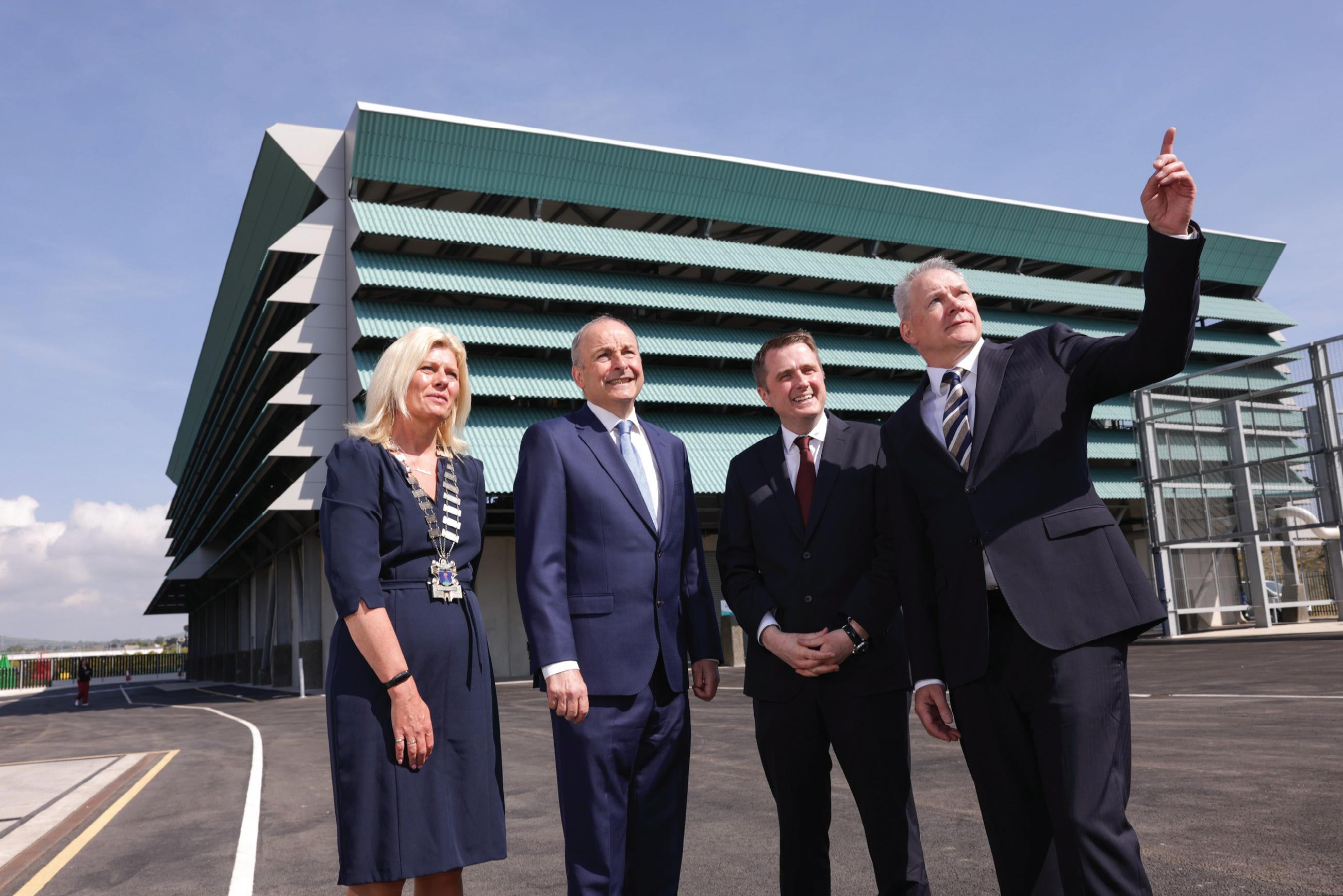
Delivering Ireland’s water future:
At Uisce Éireann, our mission is to deliver secure, safe, and sustainable water services that support Ireland’s people, communities, and economy.
From enabling housing and economic growth to protecting the environment and preparing for climate resilience, our work is central to Ireland’s future, writes Niall Gleeson, CEO of Uisce Éireann.
Supporting housing and growth
Ireland’s housing challenge is well known, and Uisce Éireann plays a vital role in addressing it. In 2024, we invested over €1.3 billion in water and wastewater infrastructure, helping deliver tens of thousands of new homes. These upgrades are about more than pipes – they unlock land for development, enable planning permissions, and assure communities that essential services are in place.
A major milestone achieved recently was the planning approval for the €1.3 billion Greater Dublin Drainage (GDD) project. This transformative scheme will serve up to 500,000 people across north Dublin, Meath, and Kildare. It will ease pressure on the Ringsend treatment plant – currently at full
capacity – and support continued housing and economic development in the capital region. As our Infrastructure Delivery Director Maria O’Dwyer said, this is “a really positive day” for Dublin’s future.
Another key project is the Water Supply Project Eastern and Midlands Region. With Government approval in principle, we are now preparing a planning application to be submitted by yearend. This project will benefit 50 per cent of the country’s population and help provide a secure, resilient water supply for the Eastern and Midlands Region including the Greater Dublin Area.
Transforming Ireland’s water infrastructure
We are undertaking the largest transformation of water services in the
State’s history. Our capital programme is delivering new and upgraded treatment plants, more resilient networks, and digital monitoring systems. In 2024, we treated 1.7 billion litres of drinking water and 1.26 billion litres of wastewater daily, achieving 99.8 per cent compliance with drinking water standards.
But transformation is also about integration. We are building a unified Uisce Éireann—breaking down legacy silos, investing in our workforce, and embedding a culture of safety, innovation, and accountability.
Valuing and enhancing our environment
Water is a precious natural resource. Our commitment to environmental protection is embedded in all we do,

from reducing leakage to improving wastewater treatment.
Leakage reduction remains a top priority. Since 2015, we have invested nearly €1 billion in the water network, aiming to reduce national leakage to sustainable levels. As a result, leakage is now at the lowest level it has ever been. We are investing €250 million in the water network every year including leak repairs, aiming to reduce national leakage to sustainable levels. But with over 65,000km of underground pipes –many old and damaged – leakage reduction is challenging, especially with rising demand in areas like Greater Dublin. But we remain committed to achieving a sustainable level of leakage by continued investment in the water network, focussing resources on areas threatened by water shortages and experiencing higher demand as a result of population and economic growth.
We are also investing in nature-based solutions and sustainable drainage systems aligned with the Water Framework Directive and the UN Sustainable Development Goals. Our approach reflects a deep respect for the environment and the role of water stewardship in climate adaptation.
Delivering our strategic goals requires sustained investment to address decades of underfunding. Historically,
only about 6 per cent of government capital expenditure went to water services, and we are still dealing with that legacy. We estimate that €55-€60 billion (in 2022 money) will be needed by 2050 to meet known needs and risks.
Encouragingly, the need for increased funding is now widely recognised. We are working closely with government, regulators, and stakeholders to ensure our funding model supports long-term planning and delivery. The Strategic Funding Plan and Water Services Policy Statement provide the framework, and we welcome the revised National Development Plan, which reaffirms government’s commitment to water infrastructure. This prioritisation reflects the essential role of resilient water services in enabling growth, supporting housing, and protecting the environment.
Public trust is earned through performance, transparency, and engagement. We are committed to clear, consistent communication with customers, communities, and stakeholders. Enhancing the customer experience is a key priority, and we are leveraging new technologies to improve our service channels and communication strategies. We are also investing in our people.
Integrating 3,000 former local authority staff is a major undertaking, and we are focused on supporting their development. Our recent campaign to promote career advancement for caretakers is one example of how we are creating opportunities and recognising dedication. A motivated, empowered team is essential to delivering world-class water services.
Our priorities are clear: support housing and economic growth, protect the environment, deliver value for money, and build a resilient, integrated utility. The challenges – from climate change to population growth – are significant, but so are the opportunities.
We are proud of the progress made, but we know there is more to do. With continued support from government, partners, and communities, we will meet the challenge.
Together, we are building a water future that is secure, sustainable, and fit for generations to come.
W: www.water.ie




In late July 2025, the Government published its latest iteration of the National Development Plan (NDP). As per its 2018 and 2021 predecessors, water infrastructure remains a major focus of the 2025 NDP, alongside critical energy and transport infrastructure, as enablers of housing delivery.
Programme for Government 2025 (PfG), Securing Our Future, emphasises the need to enhance infrastructure delivery, and prioritised an early review of the NDP. The PfG also determined that the updated NDP prioritised infrastructure investment in housing, energy, water, and transport.
The core ambition of the updated NDP is delivering the enabling infrastructure to drive the delivery of 300,000 new houses by the end of 2030 and consolidating economic competitiveness.
Between 29 May and 26 June 2025, a public consultation on the NDP review attracted 185 responses, of which 36 per cent indicated that the water sector should be a priority sector for additional investment.
For the five-year period from 2026 to 2030, a total of €36 billion of Exchequer voted capital expenditure has been allocated to the Department of Housing, Local Government and Heritage, of which €7.7 billion is earmarked for water.
On top of total Exchequer allocations (€202.4 billion), a further €10 billion in equity funding and fund releases has been provided for the period from 2026 to 2030. Of this, 21 per cent or €2 billion is being provided to Uisce Éireann in 2025 “to enable the delivery of 300,000 additional homes to 2030”. And to meet regulatory requirements.
A further €2.5 billion in non-voted funding has been allocated to specifically support the delivery of large-scale water infrastructure projects in the same
timeframe, “to build essential capacity for growth and increase the resilience and sustainability of water supply”. In total, therefore, an additional €4.5 billion of non-voted funding will be made available to Uisce Éireann.
The provision made for water infrastructure in the NDP is primarily intended to support the Uisce Éireann Strategic Funding Plan.
The updated NDP affirms: “These funds are available and ready for drawdown when required. Across all sources, including the NDP investment, a total of €12 billion has been released and earmarked specifically for critical water infrastructure investment.”
Speaking with eolas Magazine, Minister for Public Expenditure, Infrastructure,

Public Service Reform and Digitalisation
Jack Chambers TD says: “When it comes to water infrastructure, we have provided multiyear funding to Irish Water [Uisce Éireann] to drive delivery in terms of water and wastewater infrastructure. That has been a €2 billion equity injection this year [2025].
“We have set aside €2.5 billion for the Great Dublin Drainage (GDD) Scheme and the Water Supply Project for the Eastern and Midlands Region. Again, projects that are now being earmarked to give certainty to the market around the pipeline and the priority in terms of delivery, but also to allow Irish Water [Uisce Éireann] to advance other infrastructure that is not impacted by megaprojects and the €7.5 billion over a five-year period now in Exchequer funding to Irish Water [Uisce Éireann].
So, the total funding combined is €12 billion.”
Appearing before the Joint Committee on Infrastructure and National Development Plan Delivery in late May 2025, Uisce Éireann CEO Niall Gleeson stated: “For 2025 to 2029, our strategic funding plan sets out a funding requirement €10.3 billion of investment for capital infrastructure and assets. However, sustained ongoing investment will be required for many decades to offset the years of underinvestment in water services.”
Referencing the Government’s new housing target of 303,000 new units by the end of 2030, Gleeson added: “We estimate that to support Government in realising this new proposed target, an additional ring-fenced funding stream of €2 billion will be required between 2025 and 2030 to deliver the water services capacity needed for housing growth across the country.”
Uisce Éireann’s total ‘ask’ of the updated NDP, therefore, was €12.3 billion over
“When it comes to water infrastructure, we have provided multiyear funding to Irish Water [Uisce Éireann] to drive delivery in terms of water and wastewater infrastructure.”
Figure 1. Department of Housing, Local Government and Heritage gross vote capital allocated for 20262030 under the updated 2025 NDP (€ million)
five years. With this commitment, Gleeson asserted that “the supply chain will stick with us”.
Ultimately, the water sector will receive a total capital investment of €12.2 billion from 2026 to 2030, only slightly less than it advocated for.
Asked for its reaction to the updated NDP, Uisce Éireann’s response welcomes the Government’s “renewed commitment to water infrastructure investment”.
“This prioritisation of water infrastructure reflects the critical role that resilient water services play in enabling sustainable growth, supporting housing delivery and protecting the environment across Ireland,” it says, adding: “As Ireland plans for a growing population and increasing housing demand, Uisce Éireann is focused on delivering the water and wastewater infrastructure that will underpin this growth.
“Looking ahead, key national projects such as the GDD scheme and the Water Supply Project, Eastern and Midlands Region will be central to meeting long-
term demand and ensuring environmental sustainability. These transformative investments will provide the capacity and resilience needed to support housing, economic development, and climate adaptation in the decades to come. The commitment of ringfenced funding for these projects in the NDP is to be greatly welcomed.
“We are looking forward to engaging with government and state agencies to deliver on our ambitious targets, and to plan, procure, and deliver critical water infrastructure efficiently at scale. We will be working with the Department of Housing, Local Government and Heritage on the next steps in relation to funding timelines.
“Uisce Éireann remains committed to delivering safe, climate-resilient, and future-proofed water services that support Ireland’s social, environmental, and economic goals.”
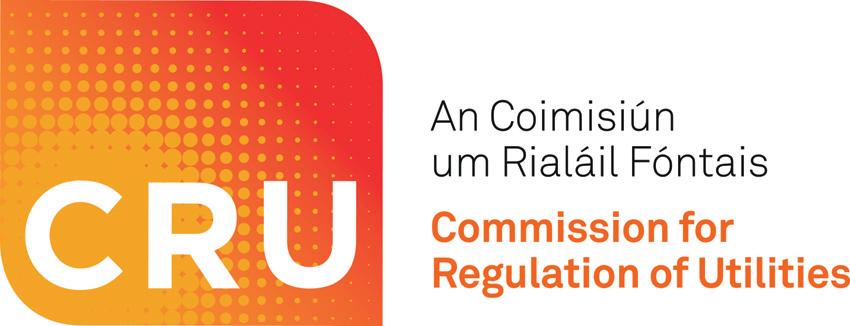
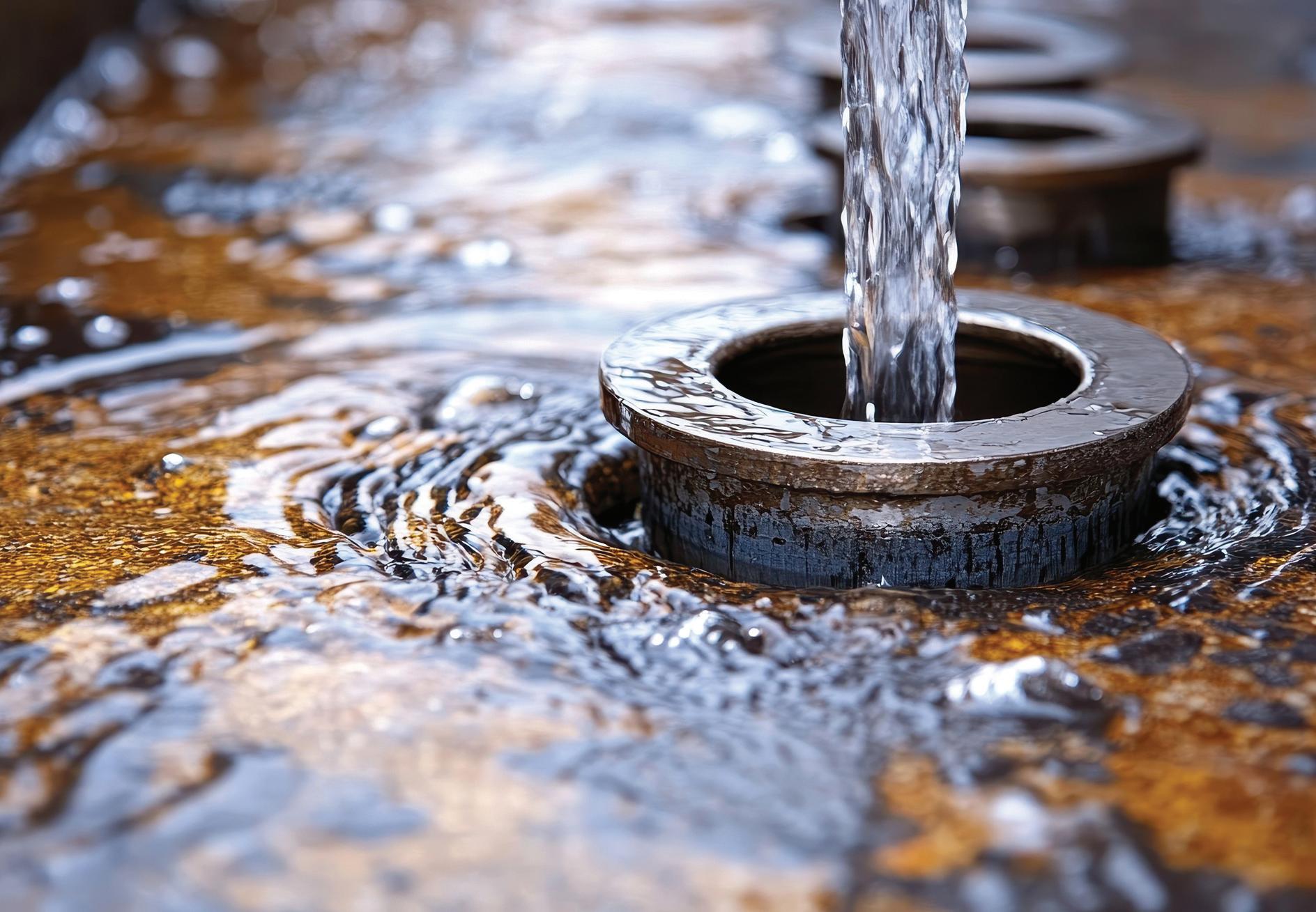

The Commission for Regulation of Utilities (CRU) plays a vital role in ensuring that water and wastewater services in Ireland are safe, reliable, and responsive to the needs of homes and businesses. Every day, 1.8 million customers rely on these essential services.
As the economic regulator for public water and wastewater services, the CRU sets performance targets and monitors the performance of Uisce Éireann in delivering services and investment in infrastructure in a cost-efficient manner to serve customers now and into the future.
The CRU is currently reviewing Uisce Éireann’s budget for the upcoming revenue control (RC4), covering 2025 to 2029. This process determines the revenue Uisce Éireann requires to operate and invest in critical infrastructure. In line with its Strategic
Funding Plan 2025-2029, the RC4 submission outlines a projected investment of up to €16.9 billion. The CRU will consult on the proposed regulatory framework that will support this investment later this year.
The approved funding will support the delivery of Uisce Éireann’s capital programme and operating costs, enabling critical improvements in outcomes for customers and communities across Ireland.
The RC4 investment strategy and allowed revenues will be adjusted to align with the National Development Plan 2021-2030, which was highlighted by the Government in its 2025 MidTerm Review. The NDP prioritises water
infrastructure as a key enabler of housing, economic growth, and climate resilience. Uisce Éireann’s planned investments under RC4 will directly support these national priorities, including:
• accelerating the delivery of housing by improving water and wastewater capacity;
• enhancing climate resilience through upgrades to aging infrastructure; and
• supporting regional development and economic competitiveness.
The CRU’s final determination, planned for early 2026, will set a revenue profile for Uisce Éireann during RC4. To note, these allowances are robustly reviewed and come with clear expectations and defined deliverables, which can be monitored and reported on throughout the RC4 period. Any changes between forecast and actual expenditure is assessed by the CRU to ensure planned outputs and outcomes are delivered for the investments funded by the exchequer and small and large businesses.
Performance will be tracked through the CRU’s Performance Assessment Framework and Capital Investment Plan Monitoring Reports, which are published annually.
These reports are a vital accountability incentive, offering independent oversight of the utility’s operations. By highlighting both achievements and areas that require improvement, the CRU challenges Uisce Éireann to remain answerable to its customers and stakeholders. The reporting process helps build public trust by showing where progress is being made and where further action is required. The cost of providing water and wastewater services is covered through a combination of exchequer funds for residential premises and tariffs for businesses. One of the key roles of CRU is to ensure the appropriate costs of providing water and wastewater to businesses in the Water Charges Plan
Uisce Éireann provides water and wastewater services to over 80 per cent of the premises in the State. The balance of premises provide their own water and wastewater services through either group water schemes or private wells and septic tanks.
to modernise the system, reduce service interruptions, cater for housing growth, and improve customer engagement. The CRU continues to monitor how this funding is allocated to ensure it delivers tangible benefits for customers and communities.
A public consultation on the CRU’s draft determination will open in Q4 2025, giving all stakeholders – including customers, businesses, and advocacy groups – an opportunity to shape the final decision. The CRU will publish its final determination in early 2026.
The CRU encourages all stakeholders to participate in the consultation. Feedback will play a vital role in shaping a regulatory framework that reflects the lived experiences and expectations of Irish water customers.

Fergal has been a member of the Commission for Regulation of Utilities (CRU) since May 2024. Fergal previously worked as the Director of the Digital Connectivity Office in the Department of Climate, Energy and the Environment and prior to that led the delivery of the Government programme to ensure all citizens have access to high-speed broadband under the National Broadband Plan He previously held a senior management role with the telecoms regulator, ComReg and various accounting and audit positions, including with PricewaterhouseCoopers in Dublin and Melbourne.
The CRU enforces minimum service standards and protects the interests of premises served by Uisce Éireann, including more than 32,000 vulnerable customers. It also oversees a range of customerfocused policies, including:
• the domestic and non-domestic customer handbooks;
• the First Fix Free scheme; and
• the First Mover Disadvantage policy.
These policies ensure that customers are treated fairly and that developers and businesses can connect to water services efficiently.
Uisce Éireann is making transformative annual investment – over €1 billion annually – in water and wastewater infrastructure. It aims
He is a Chartered Certified Accountant since 1998 and has in recent years received diplomas in Corporate Governance from UCD and Economics and Competition Law from Kings College London.
W: www.cru.ie


Conor Murphy, Professor at Maynooth University, tells eolas Magazine that the time has come to “rebalance” climate policy by integrating water adaptation and resilience into the core of Ireland’s response to climate change.

Ireland’s water systems are already under pressure from climate change, with increased flood risk, reduced summer flows, and more frequent droughts threatening ecosystems, agriculture, infrastructure, and public health.
In this context, Murphy says: “We have spent a long time focused on mitigation. Reducing greenhouse gas emissions has taken the front seat in climate policy, which is vital. But the impacts of climate change are already here. We need to bring adaptation up to the same level of urgency.”
Murphy is a lead researcher on several EPA-funded climate projects, including HydroPredict, which provides future projections of river flows and hydrological extremes, and was also a lead author to Volume 3 of the Irish Climate Change Assessment Report (ICCA).
‘Climate change is happening now’
One of the strongest examples of this came in October 2023, when Storm Babet caused widespread flooding in Midleton, County Cork. For the first time, Irish researchers were able to conduct an attribution study to determine how much of the event was driven by human-caused climate change.

“We worked with Met Éireann, Imperial College London, and others. What we found was that the likelihood of two-day rainfall events as extreme as Babet has more than doubled over the past century. The intensity of those events has increased by 13 per cent and that is directly because of human activities.”
These findings were backed by long-term rainfall and temperature records held by Met Éireann and analysed by researchers at Maynooth. “We can now clearly discern the fingerprint of anthropogenic climate change,” Murphy adds. “It is showing up in our rainfall patterns, in our temperatures, and in the increasing frequency of extremes.”



Using high-resolution models and data from 37 river catchments across the State, HydroPredict examined how climate change is likely to affect average river flows, floods, and droughts out to 2100 under different global emissions scenarios.
“The key headline is that we are likely to see increases in winter flows and decreases in summer flows. In a sustainable future where emissions are brought under control, these changes are modest, but in a high-emissions scenario, they become much more pronounced.”
By the end of the century, summer river flows could decrease by up to 40 per cent in many catchments, while winter flows could increase by 20 per cent, amplifying flood risks. “That is saturated soils, higher base conditions; catchments primed for flooding,” he says.
The impacts on low flows, which are crucial for water quality and environmental health, are even more stark. “We are seeing projected reductions of up to 40 per cent in flows exceeded 95 per cent of the time, particularly under business-as-usual emission scenarios. That has serious implications for ecosystems, abstraction, and pollution dilution.”
Murphy also highlights a major shift in drought risk, particularly for eastern and southeastern Ireland. Historically seen as a low-level challenge for the island, drought is becoming more serious due to warming-driven evapotranspiration and altered rainfall.
“Before 2018, we had not seen a major drought since the 1970s. But that changed, and what we found was that rainfall alone is not the full story,” he says. “You have to account for evapotranspiration [water lost from soils, plants, and open surfaces] driven by rising temperatures. That is why we use indices like the Standardised Precipitation Evapotranspiration Index (SPEI), not just rainfall, to monitor and project drought.”
Projections show increases in drought frequency, magnitude, and duration, particularly in spring and summer, and especially under medium and high emission scenarios. “In the east and southeast, we could see severe drought conditions becoming far more common. This has knock-on effects for agriculture, water supply, and ecosystem services.”
One of the most striking findings from HydroPredict is the clear linkage between global mitigation efforts and Ireland’s local future. “If we succeed globally in limiting emissions, the impacts on our water systems are significantly reduced,” Murphy explains. “Even for low flows and droughts, the severity of changes is much less under a sustainable pathway.”
However, he cautions that further action is required. “Even if we meet the goals of the Paris Agreement, we are still going to see change. That means we need to prepare for the 2050s and beyond. Water is fundamental to our economic and social resilience.”
Murphy argues that building resilience in the water sector is both a national imperative and a long-overdue opportunity. “We are not starting from a good place,” he says. “There has been underinvestment in infrastructure, growing demand, and inconsistent water quality. We need to change that.
“Central to this is the concept of water stewardship, which is the idea that water must be carefully managed, protected, and valued across all sectors of society. We have seen steps forward in some places, steps back in others, but we need coherent, long-term planning.
“That means investment, governance, data, and public engagement. We need robust monitoring systems, stronger integration of hydrological projections into planning, and serious political will to make water adaptation a cornerstone of our climate response.”
Concluding, Murphy says: “Climate change is already here. We can see its fingerprints in our floods, in our flows, and in our droughts. The time to adapt is now.”
Driven by strong economic performance and greater than expected population growth, Ireland’s cities and regions have experienced rapid expansion in recent years, increasing the demand for housing, services, and related enabling infrastructure.
To unlock development, the Department of Public Expenditure Infrastructure Public Service Reform and Digitisation (DPER), has identified the accelerated delivery of new infrastructure in the water, energy and transport sectors as critical to enabling all other social and economic infrastructure development and progress1
With responsibility for supplying 1.7 billion litres of drinking water and treating 1.2 billion litres of wastewater daily, Uisce Éireann operates one of the most complex utility networks in the country. The scale and scope of its challenge are unprecedented balancing aging infrastructure demands and funding constraints against climate change resilience for national water resources, population growth and rapid urbanisation, regulatory shifts, and emerging environmental standards2. At the heart of these efforts is a pressing need to accelerate water and wastewater provision which requires a strategic and streamlined approach to national infrastructure planning and delivery.
While cities and urban centres attract significant investment returns, balanced regional investment remains a key national priority. The Small Towns and Villages Growth Programme (STVGP) spearheaded by Uisce Éireann is a national programme designed to ensure that existing water infrastructure in smaller towns and villages can support economic growth and new housing needs (Figure 1). The programme supports:
• sustainable growth and development across towns and villages, while protecting the environment and ensuring a continued supply of safe drinking water;
• delivery of national policy objectives and national strategic outcomes under the National Planning Framework, by ensuring that essential infrastructure is provided within each local authority area; and
• alignment with County Development Plans to enable targeted local investment.
1:https://assets.gov.ie/static/documents/Report_on_Engagement_and_Barriers_to_Infrastructure.pdf
2: www.water.ie
3: https://www.water.ie/projects/national-projects/small-towns-villages-growth-programme
Uisce Éireann seeks to address wastewater treatment capacity and compliance issues at up to 840 wastewater treatment plants nationally. To date, 39 projects have been approved through the STVGP Programme nationally and an additional 11 towns and villages will also be delivered through complementary Uisce Éireann programmes.
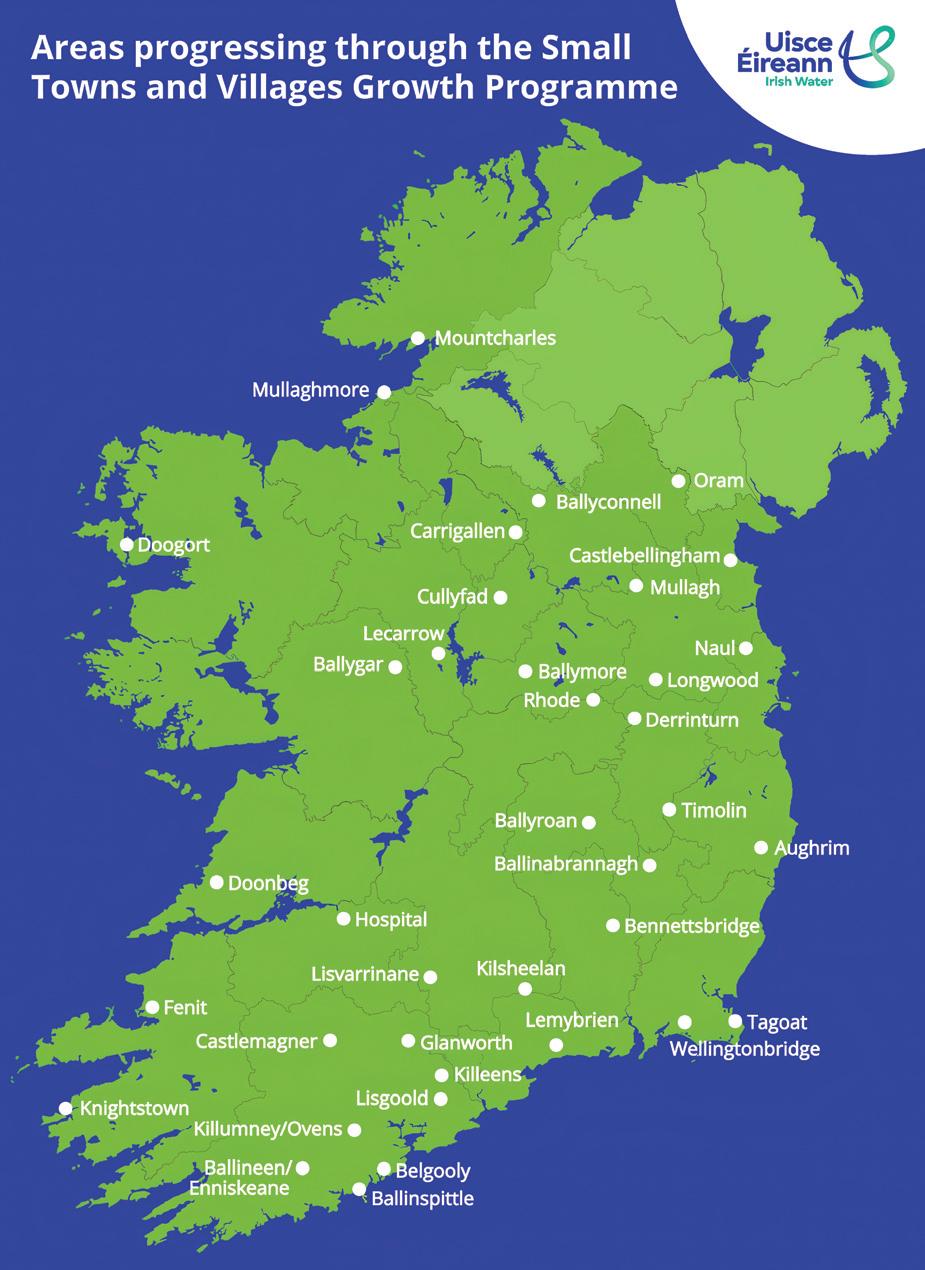
The STVGP complies with the relevant requirements of the National Infrastructure Guidelines published in December 20234. A multi-stage approvals process facilitates the delivery of capital projects and project stages are subject to procurement, planning, legal and environmental regulations.
4: https://www.gov.ie/en/department-of-public-expenditure-infrastructure-public-service-reform-anddigitalisation/collections/infrastructure-guidelines/

There are 4 key project stages:
• 1: Strategic assessment;
• 2: Preliminary business case;
• 3: Final business case; and
• 4: Implementation (construction).
Jacobs supported Uisce Éireann in developing a preliminary business case (PBC) Factory model to accelerate the delivery of the STVGP. Adopting a programmatic approach model, the PBC Factory is designed to optimise productivity and streamline project lead times through its approval process, accelerating the development of a pipeline of construction ready schemes.
A programmatic approach provides an effective delivery model to prioritise critical projects, manage and sustain resources and streamline the overall delivery process. The packaging of projects into a long-term programme also allows utilities and their supply chain to invest in their teams and to build long-term and collaborative working relationships that support innovation and deliver tangible improvements to the delivery process.
Working collaboratively with Uisce Éireann stakeholders, Jacobs developed a delivery process for the PBC Factory that focussed on achieving consistent and efficient outcomes by standardising methods for multi-criteria option assessment to provide data driven decisions to option design, financial appraisal, climate resilience, carbon and renewable energy
5: www.jacobs.com
assessment, and project reporting. The delivery process agreed streamlined touchpoints and review periods for project stakeholders, and a focus on securing consistent outcomes.
The PBC Factory approach is already delivering results – it has improved the STVGP efficiency reducing the burden on stakeholders while developing a long-term programme of upgrades for delivery. The collaborative environment has also enabled the deployment of innovative technology solutions for efficient data analysis, commercial appraisal, and reporting to improve the productivity of the delivery teams.
As a global leader in resilient and sustainable infrastructure solutions, Jacobs brings a wealth of expertise to helping clients navigate critical national challenges5. In Ireland, we have supported more than €50 billion worth of award-winning critical infrastructure projects across sectors including working with the National Transport Authority, Uisce Éireann, the Land Development Agency and IDA Ireland among others.
From this experience of planning and delivering significant infrastructure projects globally and locally, we have identified three key success factors for infrastructure:
Programmatic delivery models offer significant potential for more efficient

use of existing resources to meet immediate challenges while bringing longer term certainty allowing for sectoral development and innovation.
A programmatic model allows for economies of scale, shared services, and data-driven optimisation across portfolios. This enhances delivery performance and resilience, particularly in a constrained labour and supply chain environment.
A longer-term approach provides the space for collaboration and improved processes that can streamline the delivery of outcomes and improve the overall productivity of the sector.
To meet the scale of tomorrow’s challenges and to enable communities all across Ireland to thrive, we must proactively integrate and improve delivery systems, accelerate innovation and deliver infrastructure that supports growth, safeguards public health and enhances the environment.
E: Nick.Stokes@jacobs.com W: www.jacobs.com

Climate Action Plan 2025 (CAP25) includes minimal actions to achieve the United Nations’ sustainable development goal (SDG) of ‘clean water and sanitation’ despite the Sustainable Progress Index 2025 –published by Social Justice Ireland in February 2025 – placing Ireland joint-10th out of 14 countries for delivering on the SDG.
CAP25 includes progress on six out of eight targets set under the SDG, which is central to the plan’s approach to climate action for water resources. The first target the plan addresses is that universal and equitable access to safe and affordable drinking water for all be achieved by 2030. Progress on this target is measured by the proportion of the population using safely managed drinking water services.
This is addressed under the Public Sector Climate Action Mandate outlined in CAP25. The mandate applies to all bodies covered by decarbonisation targets except for local authorities, commercial semistate bodies, and the school sector. It traces an aim to provide a suitable drinking water refill point for staff “in any premises accessed by the public”. However, the
document lacks details on the proportion of the population using safely manged drinking water services.
The second SDG target progressed under CAP25 is that water quality be improved by 2030 by reducing pollution, eliminating dumping and minimising the release of hazardous chemical and materials, halving the proportion of untreated wastewater, and increasing recycling and safe reuse. Progress indicators include the proportion of safely treated domestic and industrial wastewater flow, and the proportion of bodies of water with good ambient water quality.

In line with this, CAP25 set an aim for a sectoral adaptation plan for the water quality sector to be created. The draft Water Quality and Water Services Infrastructure Sectoral Adaptation Plan 2025 underwent public consultation between July and August 2025. It includes actions to reduce pollution, address release of chemical materials, and improve wastewater infrastructure. CAP25 also sets an aim to improve the resilience of Ireland’s water infrastructure through implementation of a Nature Based Solutions Programme.
CAP25 also progresses target 6.4 of the SDG to increase water-use efficiency in all sectors, ensure sustainable withdrawals and supply of freshwater, and reduce the number of people suffering from water scarcity. One action in the Public Sector Climate Action Mandate asserts that organisations must measure and monitor their total water usage. Indicators of progress on this target include a change in water-use efficiency over time, and freshwater withdrawal as a proportion of available freshwater resources.
Another target of the SDG is to implement integrated water resources management at all levels, including through transboundary cooperation by 2030. Indicators of progress on this target are the degree of integrated water resources management and the proportion of transboundary basin area with an operational arrangement for water cooperation. CAP25 does not include any actions which contribute to this target.




Target 6.6 of the SDG is that waterrelated ecosystems will be protected and restored by 2020. Although the deadline for this target has passed, multiple actions in CAP25 align with it. The plan stipulates that action be taken to restore wetlands and outlines that the National Parks and Wildlife Service will continue to implement a €12 million restoration scheme in the midlands. In 2025, works will begin on the first phase of wetland sties selected for restoration while phase two will encompass the creation of further restoration plans.
CAP25 notes that inventory refinements in 2024, including revision to the drainage status and associated
emissions factors for grassland on peat soils and peat extraction on wetlands, saw a 45 per cent reduction in reported national emissions. The document insists that these refinements will continue for the sector.
Target 6.b sets an intention to strengthen the participation of local communities in improving water and sanitation management. The indicator of progress is the proportion of local administrative units with established and operational policies and procedures to enable local communities’ participation.
CAP25 notes that climate engagement campaign Climate Action Works (CAW) was established in 2024 to support local communities in climate action. The plan also points to research initiatives like Climate Conversations 2025, behavioural studies, and expanded stakeholder for a as examples of efforts to engage with communities on the transition to climate neutrality. However, it does not include any actions regarding the establishment of local administrative units.
In addition to the SDG, CAP25 states that designated projects aimed at improving water quality will be supported through the €3.15 billion Infrastructure, Climate and Nature Fund between 2026 and 2030. The first European Climate Risk Assessment, published in March 2024, identifies water as one of the resources endangered by 36 climate risks. To address these risks, various local authorities signed the EU Adaptation Mission Charter. Each has received support from Climate Matters to address the unique challenges they face.
The Sustainable Progress Index 2025 states that results for this SDG in Ireland are mixed: “Indicators for access to improved drinking water and sanitation show further development is required. The proportion of wastewater that is treated is lower in Ireland relative to the best performing countries.
“On a positive note, Ireland scores well on Eurostat’s water exploitation index, which is a measure of total freshwater use as a percentage of the renewable freshwater resources.”
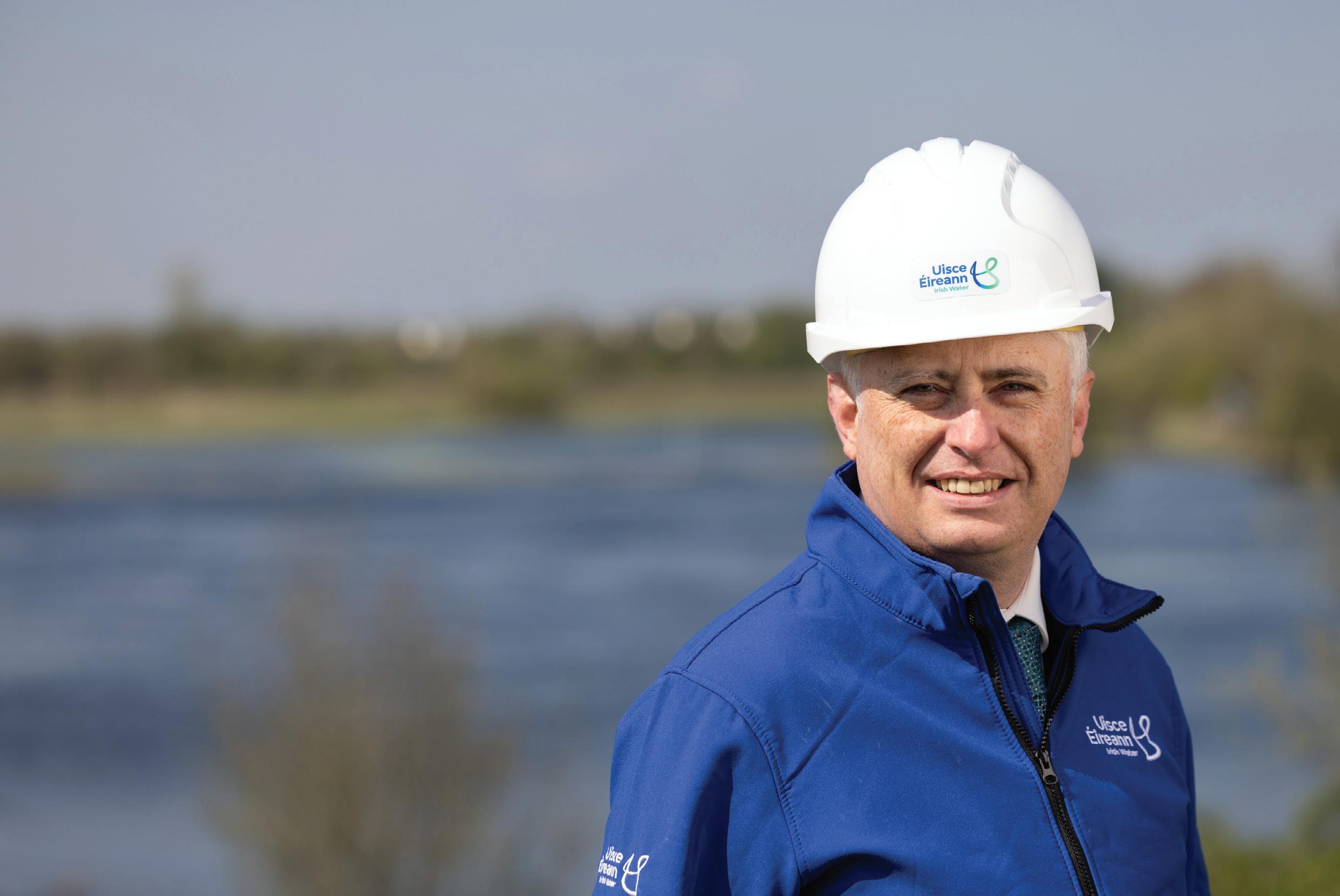
Michael
Tinsley, Infrastructure Delivery Senior Portfolio Manager with Uisce Éireann: Over 85 per cent of raw sewage discharges by volume have been eliminated.
At Uisce Éireann, we believe that every community deserves clean water and a healthy environment, writes Michael Tinsley, Infrastructure Delivery Senior Portfolio Manager, Uisce Éireann.
For too long, untreated wastewater has flowed into rivers, estuaries, and coastal waters across Ireland. This is not just an environmental issue; it is a public health concern, and a barrier to development in many rural communities.
That is why we are committed to ending raw sewage discharges from all the towns and villages that have never had wastewater treatment. It is a hugely ambitious infrastructure programme, and it is central to our mission of delivering safe, sustainable water services for all.
In 2014, 50 locations across Ireland were identified as discharging raw sewage daily. These were communities where public sewers existed, but no treatment plants had ever been built. Since then, we have made significant progress. As of mid-2025, 35 of these locations have been completed, and six more are under construction. That means over 85 per cent of raw sewage discharges by volume have now been eliminated.
There are plans for the remaining nine locations, prioritising the areas where we can make the biggest impacts first. However, these remaining locations face a number of complex barriers, including planning and licensing issues, site acquisition delays, and legal challenges.
The opening of the Arklow Wastewater Treatment Plant this year marked a major milestone. Serving a population equivalent of 24,000 (with the capacity to expand to 36,000), this facility has ended the daily discharge of the equivalent of 14,000 wheelie bins of raw sewage into the Avoca River. It is a symbol of what we can achieve when planning, funding, and community support align.
Speaking at the launch of the Arklow Wastewater Treatment Plant in May, An Taoiseach Micheál Martin TD noted that projects like this highlight the vital role of strategic infrastructure investment in meeting the country’s demand for housing while also protecting and enhancing the environment.
Other areas that have seen the benefits of our investment in eliminating raw sewage include Cóbh and Ringaskiddy in County Cork; Kilrush and Liscannor in County Clare; Bundoran in County Donegal; Rush in Dublin; Spiddal in Galway; Ballylongford in County Kerry; Killala and Belmullet in County Mayo; Dunmore East in County Waterford; and Kilmore Quay in County Wexford.

For a full list of areas where projects have been completed or an underway see www.water.ie/rawsewage
Uisce Éireann is committed to providing treatment in the remaining nine locations. However, this is not without its challenges, and we have experienced delays in obtaining the necessary statutory consents for the projects and encountered legal challenges in a number of locations.
Our teams are required to engage with multiple legislative regimes and multiple competent authorities when obtaining consent for upgrades and the construction of new infrastructure.
For example, an upgrade to a Wastewater Treatment Plant may require a planning permission, a wastewater discharge authorisation, a foreshore licence, and landowner consents, such as wayleaves or CPO. This requires each consenting authority to enter into separate independent deliberative processes, each of which is subject to its own timelines, delays and the potential for judicial review of each decision.
We acknowledge the significant progress that is being made in planning reform. When the Planning and Development Act 2024 is commenced,
we expect that we will benefit from statutory decision-making timelines for An Coimisiún Pleanála.
We also acknowledge the Ministerial Action Plan on Resourcing the Planning Sector, and the additional resources provided to An Coimisiún Pleanála should enable them to meet their deadlines. We are continuing to engage with government and regulators to explore reforms that would prioritise critical infrastructure and streamline approvals.
Our messaging is clear and consistent: untreated wastewater is unacceptable, and we are committed to ending it. The raw sewage programme is not just about pipes and plants; it is about supporting communities, protecting nature, and enabling growth.
Behind each one of these projects is a community that has lived with the consequences of untreated wastewater.
In Newport, County Mayo, for example, two untreated discharges continue to threaten shellfish waters and recreational areas. Our plan to build a new treatment plant and outfall will transform the local environment and support tourism and growth. But delays in licensing have stalled progress, and the community is still waiting.
The elimination of raw sewage discharges is a cornerstone of our strategic plan. It aligns with our commitments under the Water Services Policy Statement, the National Planning Framework, and the EU Urban Wastewater Treatment Directive. It supports housing, protects the environment, and builds public trust.
But we cannot do it alone. We need continued support from Government, regulators, and communities. We need planning reform, licensing clarity, and sustained investment. And we need to keep telling the story – of progress, of challenges, and of the people we serve.
At Uisce Éireann, we are proud of what we have achieved. But we know there is more to do. Together, we will end raw sewage in Ireland and build a wastewater system that is fit for the future.
W: www.water.ie


eolas Magazine analyses the implications of the recast Urban Waste Water Treatment Directive, which entered force at an EU level in January 2025.
The recast Urban Waste Water Directive, formally called Directive (EU) 2024/3019, adopted in November 2024 and entering into force on 1 January 2025, replaces the 1991 Urban Waste Water Treatment Directive (91/271/EEC). The revision aims to modernise the European Union’s approach to urban wastewater management, introducing new obligations for member states in relation to pollution control, climate resilience, energy neutrality, and the treatment of micropollutants. The directive introduces a number of structural and regulatory changes that will be of particular relevance to Ireland, given the challenges that persist in areas such as infrastructure investment, treatment standards, and compliance monitoring.
The 1991 Directive, which formed the basis for urban wastewater policy across Europe for over 30 years, focused primarily on the collection and treatment of municipal wastewater and industrial discharges from agglomerations exceeding certain population thresholds.
While it succeeded in driving improvements in wastewater infrastructure across the EU, including in Ireland, the directive had become outdated. It did not adequately address pollutants of emerging concern, nor did it reflect the wider environmental and climate-related priorities introduced through subsequent EU environmental and public health legislation. The recast directive aims to address these shortcomings while aligning the wastewater sector with broader objectives under the European Green Deal, the Zero Pollution Action Plan, and the Circular Economy Action Plan.
A key new requirement in the revised directive is the introduction of quaternary treatment for micropollutants. Member states will be required to ensure that treatment plants remove a significant proportion of pharmaceuticals and other chemical substances that may be present in urban wastewater. Specifically, agglomerations with a population equivalent (PE) greater than
150,000 must equip treatment facilities with additional treatment stages designed to remove at least 80 per cent of targeted micropollutants by 2045. Intermediate compliance targets require that 20 per cent of such plants be upgraded by 2033 and 60 per cent by 2039. Treatment plants serving populations between 10,000 and 150,000 PE will also be subject to this requirement where they discharge into sensitive water bodies, including bathing waters, drinking water sources, and protected habitats.
In the Irish context, this will apply directly to major urban centres such as Dublin, Cork, Limerick, and Galway, and potentially to a number of regional towns with discharges into environmentally sensitive areas. The implications for capital planning are significant, as the scale and complexity of quaternary treatment systems are expected to require large-scale infrastructure upgrades. The Environmental Protection Agency (EPA) has previously identified
consistent underperformance at a number of Irish treatment facilities, and the implementation of this aspect of the directive will likely require accelerated investment and strategic oversight by Uisce Éireann in coordination with the Department of Housing, Local Government and Heritage.
Another major policy development in the revised directive is the establishment of an Extended Producer Responsibility (EPR) scheme. Under this provision, the pharmaceutical and cosmetics sectors will be held financially responsible for contributing to the costs associated with the removal of micropollutants from urban wastewater. From 31 December 2028, manufacturers placing products on the EU market that contain substances listed in the directive must provide financial contributions to cover a substantial share of the cost of quaternary treatment, as well as monitoring, reporting, and administrative functions related to the EPR system. Member states are required to establish transparent governance mechanisms to administer these schemes, and to ensure that financial contributions are proportionate and equitable.
The EPR provision introduces a new funding model for wastewater treatment that shifts a share of the financial burden from water consumers and public authorities to producers. In Ireland, the implementation of the EPR system will require legislative and administrative preparation, including engagement with affected industries and the designation of competent authorities for oversight and enforcement. It may also create opportunities for environmental innovation and reformulation in the pharmaceutical and cosmetics sectors, in line with green chemistry objectives.
The directive also introduces binding targets for energy neutrality in the wastewater sector. Member states must ensure that, by 2045, energy consumption in urban wastewater collection and treatment processes is balanced by renewable energy production and energy recovery measures. Treatment facilities with a capacity greater than 10,000 PE will be required to conduct regular energy audits and report energy consumption and greenhouse gas emissions. Interim targets in 2033 and 2039 are intended to support phased progress toward full energy neutrality. This requirement aligns wastewater policy with EU climate objectives, but also introduces operational challenges, particularly for
• 1 January 2025: Directive (EU) 2024/3019 enters into force at EU level
• 31 July 2027: Ireland must transpose directive into national law
• 31 December 2028: Extended Producer Responsibility (EPR) schemes for pharmaceuticals and cosmetics must be operational
• By 2033: Minimum 20 per cent of treatment plants >150,000 PE must have quaternary treatment installed
• By 2039: Minimum 60 per cent of treatment plants >150,000 PE must meet quaternary treatment requirements
• By 2045: All relevant plants must comply with quaternary treatment and energy neutrality targets
older treatment plants that lack modern energy recovery systems.
In Ireland, achieving energy neutrality will likely require a combination of technological upgrades, increased investment in on-site renewable generation (such as solar photovoltaics and biogas), and changes in operational management. Uisce Éireann will be responsible for coordinating the implementation of these requirements.
Further requirements relate to climate adaptation and integrated planning. The directive mandates that member states conduct vulnerability assessments of wastewater infrastructure in light of climate risks, including flooding, extreme rainfall, and sea-level rise. For agglomerations of 1,000 PE or more, integrated urban wastewater management plans (UWMPs) must be prepared, taking into account urban drainage, runoff management, and the use of nature-based solutions. These plans must be regularly updated and coordinated with other water-related planning instruments, including river basin management plans under the Water Framework Directive.
The directive also strengthens rules on monitoring, public access to information, and data reporting. Operators will be required to make treatment performance,
energy consumption, emissions, and compliance data available to the public, including through digital platforms. Rules on biomedia containment, sludge reuse, and treated wastewater reuse are also updated, reflecting a more circular approach to wastewater management.
Ireland, like all member states, must transpose Directive 2024/3019 into national law by 31 July 2027. The Department of Housing, Local Government and Heritage, in collaboration with the EPA and Uisce Éireann, will be responsible for overseeing this process. Legislative changes, administrative systems, and investment planning will need to be aligned in a relatively short timeframe to ensure compliance with the new obligations.
Broadly, the directive introduces a number of complex requirements across infrastructure, finance, governance, and environmental monitoring. While the long-term benefits are expected to include improved water quality, reduced pollution, and more resilient wastewater systems, the short- and medium-term challenges are substantial and will require coordinated and sustained policy action.
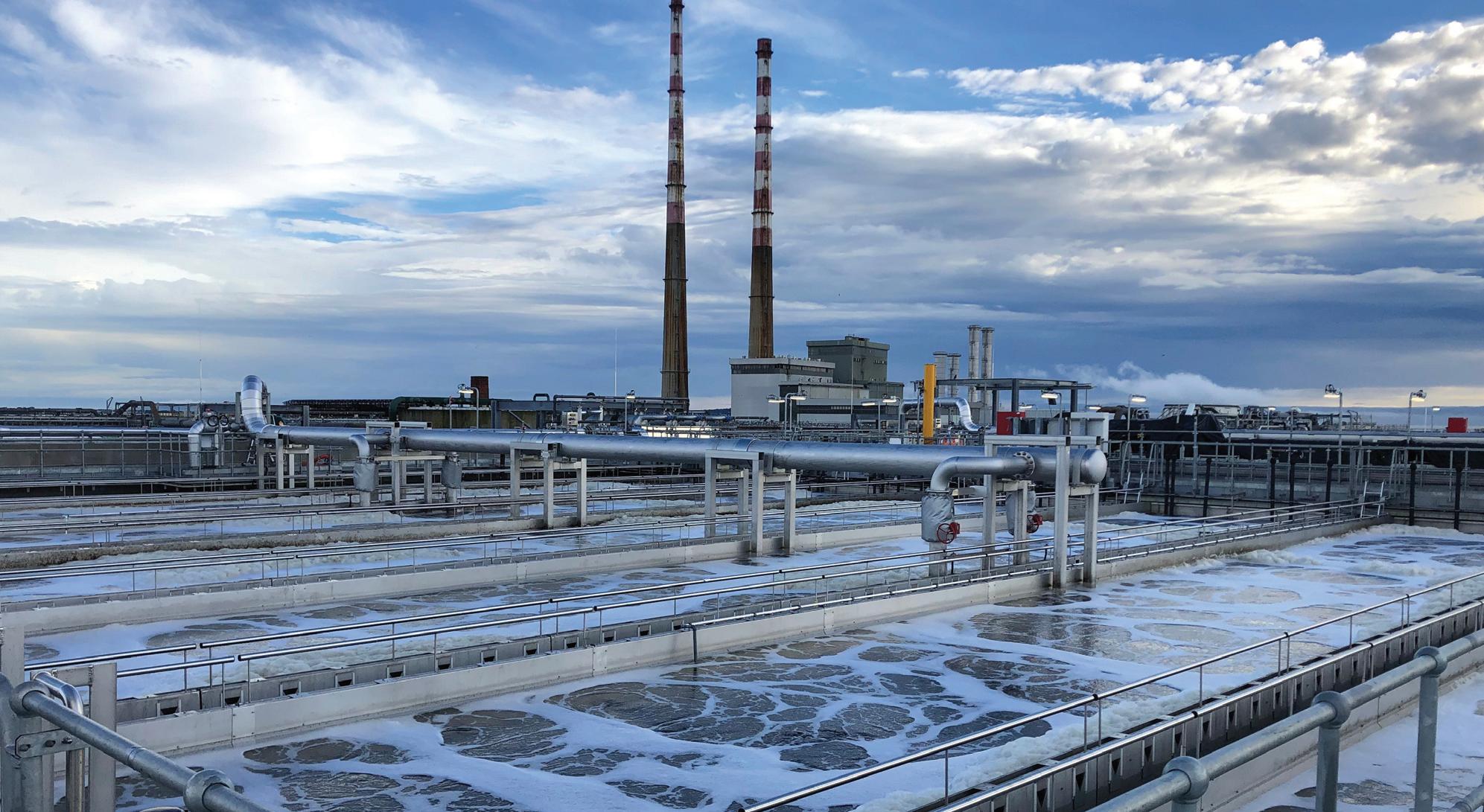
Amid increased investment in Ireland’s water infrastructure, Egis is expanding its capacity and stands ready to add to its existing project portfolio.
Ireland’s water network has been stretched to breaking point by decades of underinvestment. Uisce Éireann is working to upgrade ageing systems while building new facilities to meet the needs of a fast-growing population, rising housing demand, and higher environmental standards.
The utility oversees 8,000 water and wastewater assets involving 90,000km of pipework. It invests about €1.4 billion each year on capital projects and it has already made considerable progress.
Dublin’s upgraded Ringsend Wastewater Treatment Plant, for example, now processes about 40 per cent of the country’s wastewater following a €500 million upgrade. Meanwhile, a series of modernisation projects are underway to improve services nationwide. Yet, there is more to do.
The utility has said it needs over €10 billion between now and 2029 for capital projects, and a further €2 billion to service increased housing output under the National Development Plan.
To assist in realising its strategies, Uisce Éireann accesses expertise and extra
resources by awarding contracts to the private sector. Egis, one of Ireland’s largest multi-disciplinary engineering and operations firms, is already directly involved in supporting the utility’s work programme with services ranging from feasibility, design, and planning to construction supervision.
Current Egis projects include the Inlet Works Storm and Sludge programme, which involves upgrading 60 wastewater treatment plants to bring them into compliance, extend their lifespan and improve efficiency.
Egis also worked with partners on the upgrade and flood proofing of the Lee Road Water Treatment Plant and managed the design, engineering and project management of the Ringsend Wastewater Treatment plant upgrade.
Elsewhere. the company is providing design expertise in partnership with EPS Group, Farrans Sorenson, and Glanua on projects throughout the country.
Egis’ 2023 acquisition and integration of JB Barry & Partners, a leading engineering firm, further strengthened its competence in this sector. It has also
been enhanced by recent leadership developments, including the appointment of Joanne Moran as Regional Service Line Director for Water, Environment and Energy Transition, and Marcus Fagan as Director for Water for Ireland and the UK.
This reconfiguring of the water leadership team reflects the firm’s commitment to respond to the increased levels of investment being made in water infrastructure in both regions.
Active in Ireland since 1994, Egis employs more than 630 staff across 16 locations, with a portfolio ranging from water projects to operating major transport assets such as the Dublin Tunnel.
With experience spanning decades, multiple regions, and every stage of the water project lifecycle, the company is well placed to help deliver the transformative infrastructure that Ireland now urgently needs.
W: www.egis-group.com
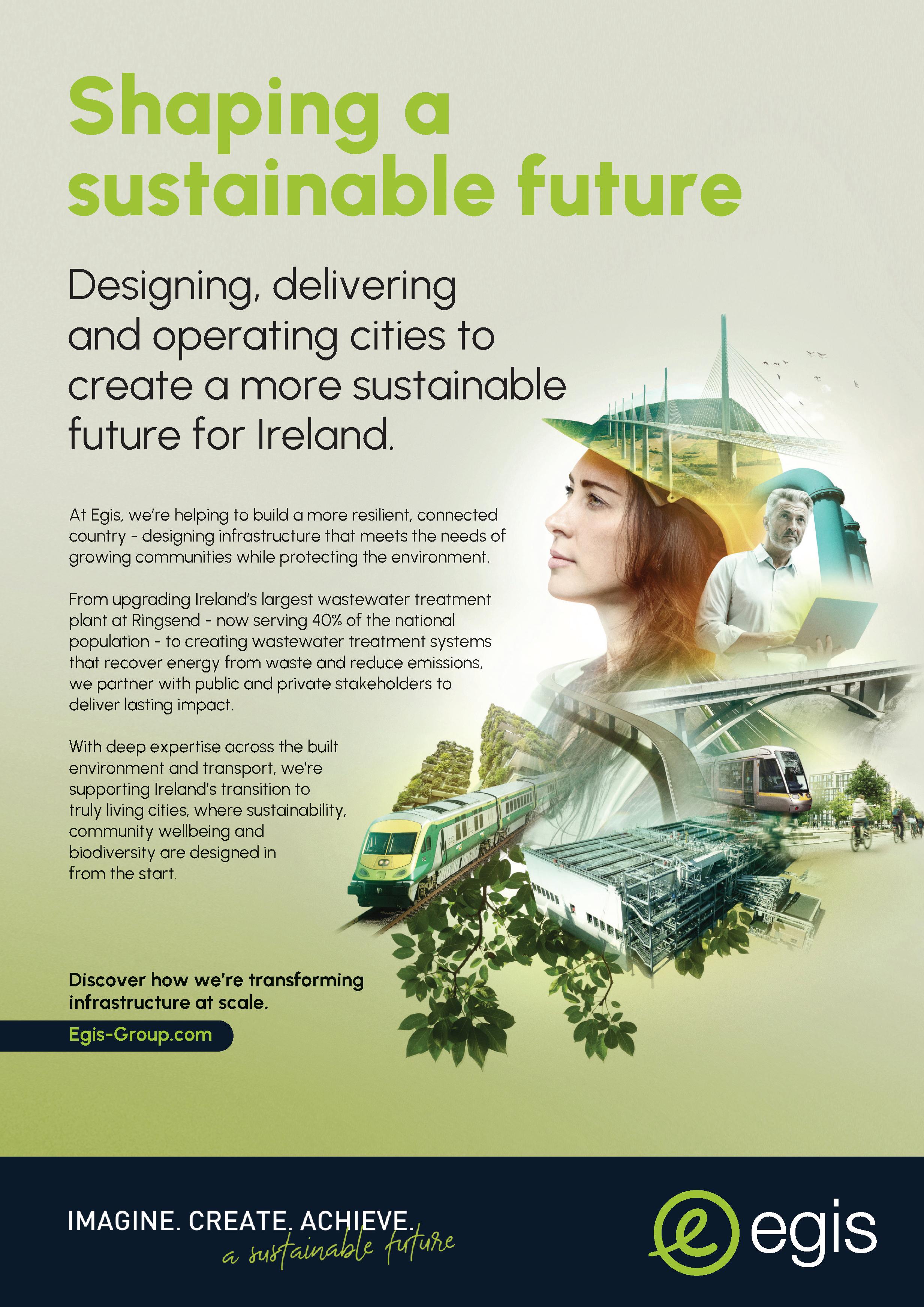

With 96 per cent of assessed bathing waters reaching the minimum required standard for water quality, Irish bathing water quality remains ‘overall very good’.

In 2024, of the 151 identified bathing waters assessed, 145 (96 per cent) met or surpassed the minimum required standard of sufficient. In total 122 waters (81 per cent) were of excellent quality, a marked increase from 114 (77 per cent) in 2023.
The vast majority of bathing waters have excellent or good quality:
• 96 per cent of the 151 identified bathing waters met or exceeded the minimum standard.
• 122 bathing waters (81 per cent) were of excellent quality, a sizable increase from 114 for 2023.
• Two bathing waters were poor, (down from five for 2023) and the Environmental Protection Agency (EPA) have confirmed that both will have a swimming prohibition for the 2025 season. These are Lady’s Bay, Buncrana in County Donegal and Sandymount Strand in Dublin.
• One bathing water – Half Moon, Dublin – was classified for the first time with excellent quality.
Three beaches – Front Strand, Loughshinny Beach in Fingal, and Trá na mBan, An Spidéal in County Galway – previously had poor quality in 2023. After Special Management Plans were put in place, samples taken in 2024 have shown improvements in water quality for all three bathing waters.
At Trá na mBan, An Spidéal, a new water treatment plant has been commissioned, and all samples taken in 2024 returned results of excellent water quality. In Balbriggan, identification and resolution of storm water misconnections have contributed to improved results. Both beaches are in a temporary category while improvements are monitored. Loughshinny Beach water quality has increased from poor to sufficient for 2024.
Urban wastewater was most frequently reported as the likely cause of incidents in 2024. Other reported causes included agricultural runoff, contamination from animals/birds and pollution entering the surface water collection system through misconnections or runoff from urban areas.
Heavy rainfall can result in wastewater overflows and in runoff from agricultural lands and urban areas, which can cause short-term deterioration in water quality. With 2024 being a drier year than 2023, there were less than half of the bathing water warnings in 2024 (113) compared to 2023 (275).

Contamination
Septic
Source: EPA
In 2024 the EPA was notified of 34 pollution incidents which resulted in the closure of bathing waters, down from 45 in 2023. The majority were due to the presence of pollution in sample results (18 incidents) and due to algal blooms (1 incident). Bathing waters were also closed as a precaution after overflows in the sewer network (15 incidents).
Under the Bathing Water Directive, over 22,000 bathing waters are monitored throughout Europe. Ireland, with 81 per cent of bathing waters having excellent quality, is below the EU average of 85 per cent. In five countries – Cyprus, Bulgaria, Greece, Austria, and Croatia – 95 per cent of bathing waters were of excellent quality. Poland, with 58 percent, had the worst results in the EU.
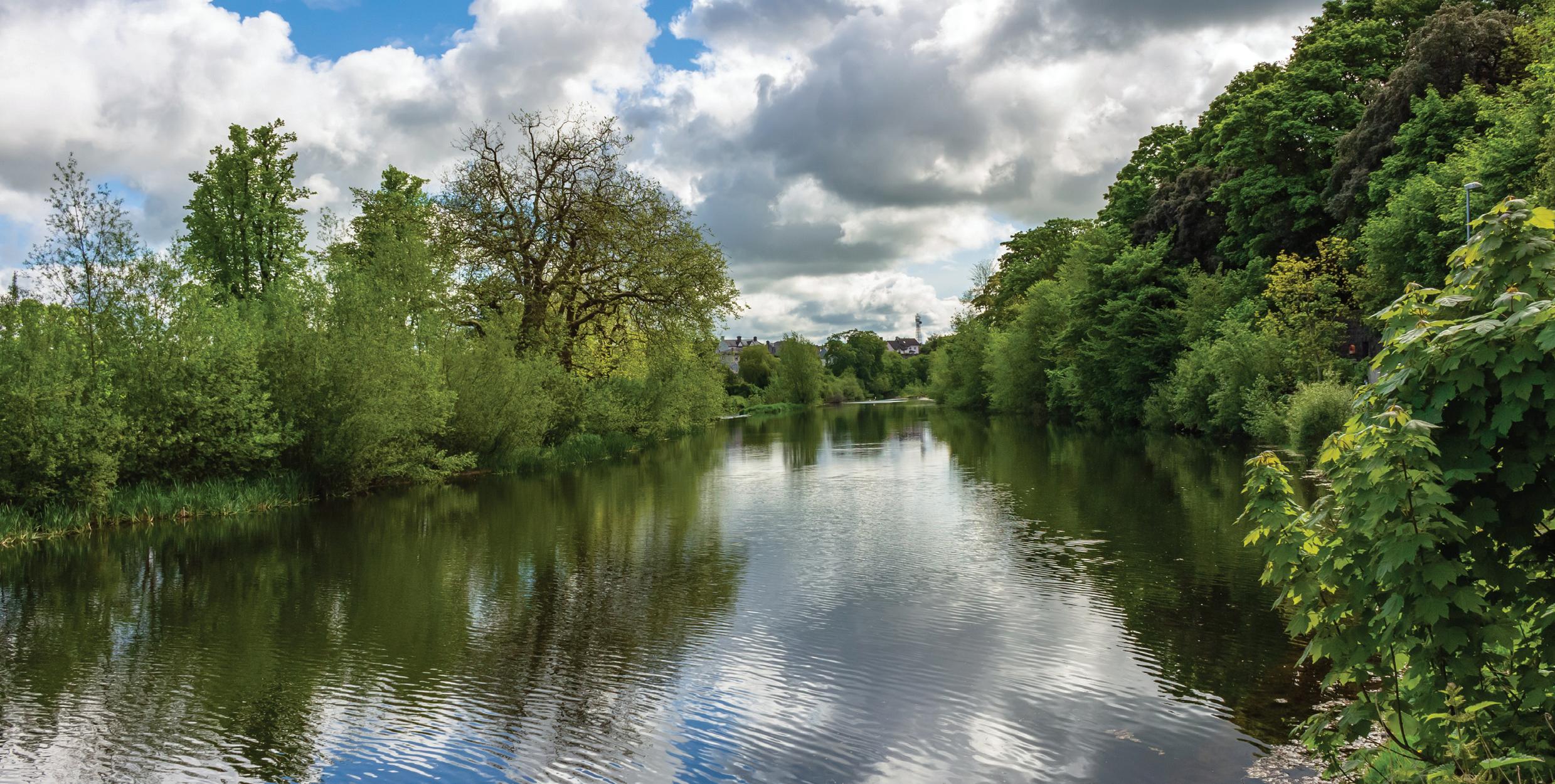
Up to 466 water bodies throughout Ireland could be designated as heavily modified water bodies (HMWBs) in the next River Masin Management Plan 2028-2033.
This proposed designation follows a comprehensive technical assessment by the Environmental Protection Agency (EPA) in 2022 and reflects a significant evolution in the State’s approach to water resource management.
Previously, only 33 water bodies had been designated as HMWBs. The expansion to 466 water bodies comprises 433 rivers, 20 lakes, and 13 estuarine or coastal waters.
The expanded candidate list reflects recognition that significant hydromorphological alterations have historically occurred to support specified uses.
Under the EU Water Framework Directive (WFD), HMWBs are those whose physical characteristics have been significantly altered for a specified use, making the achievement of Good Ecological Status (GES) impractical
without causing disproportionate socioeconomic or environmental harm. Instead, these water bodies are assessed against the alternative objective of good ecological potential (GEP).
The Department’s review, informed by additional data from specified use owners, determined that in all 466 cases, achieving GES would either “compromise vital services” or prove “technically or financially unviable”. These findings are designed to ensure that the RBMP’s objectives remain aligned with both environmental goals and Ireland’s infrastructural realities.
Going ahead, HMWBs must be integrated into regulatory, planning, and licensing frameworks. The EPA has proposed defining and monitoring GEP targets using the Mitigation Measures (Prague) Approach, emphasising
improvements where feasible while safeguarding critical human uses.
The designation will be revisited in future planning cycles as national policy evolves particularly in areas such as arterial drainage, land use, and flood management, and as ecological assessment tools become more refined.
The public consultation on the designation of Heavily Modified Water Bodies closed on 23 May 2025, following an eight-week period for stakeholder engagement.
Planning for the fourth-cycle RBMP (2028-2033) is underway, with a public consultation having closed for submissions on 25 July 2025.
This article was updated on 26 August 2025 to reflect an error in designation of a source.

Ballinabranna Group Water Scheme, County Carlow, was awarded the Excellence Flag for Outstanding Community Engagement at the 2024 GWS Excellence Awards. (L–R): Mark Farrelly (CEO, NFGWS), Senator Malcolm Noonan, Gail Fitzgerald (Ballinabranna GWS), Róisín Dowd Smith (NFGWS), and Douglas Kelly (DHLGH).
The National Federation of Group Water Schemes (NFGWS) continues to play a pivotal role in helping to safeguard rural Ireland’s drinking water through its newly launched Strategic Plan 2025-2030.
The organisation is the representative body for circa 380 community-owned group water schemes (GWSs), who provide potable water to 200,000 across rural Ireland. At the heart of the NFGWS’s mission is a commitment to empowering GWSs through expert guidance, training and advocacy, ensuring that they deliver professional and resilient water services.
The NFGWS’s strength lies in its collaborative ethos. Through strong partnerships with the Department of Housing, Local Government and Heritage, local authorities, and like-minded organisations, the Federation ensures that the voice of rural communities is heard at every level of policy and decision-making. Its role in national forums and working groups further amplifies the sector’s contribution to Ireland’s water and environmental goals.
Mark Farrelly, NFGWS CEO, says: “This Strategic Plan is a confident declaration of what is possible when communities, expertise, and vision come together. We are not just preparing for the future, we
are shaping it. With our member group water schemes at the heart of everything we do, the NFGWS is committed to building a resilient, innovative, and sustainable rural water sector that will serve generations to come.
“The GWS sector is a vital component of rural Ireland, helping to ensure it is a vibrant place for people to live and work.”
A key feature of the strategic plan is its emphasis on rural community participation and governance. GWSs continue to promote inclusive leadership through their voluntary boards and create opportunities for all ages to get involved in source protection.
The recent Biodiversity Enhancement and Climate Action (BECA) pilot project has provided the sector with a blueprint for future positive local involvement thanks to its success in highlighting the impact of community on source protection and wider environmental initiatives. The sector’s commitment to innovation is evident in its support for research
partnerships and pilot projects that explore new technologies and operational models.
Its strategic plan is not just a roadmap for the next five years, it is a testament to the enduring value of co-operative action in delivering vital public services.
To read the full Strategic Plan and for more information on the National Federation of Group Water Schemes, please visit: E: info@nfgws.ie W: www.nfgws.ie
The European Commission has launched a Water Resilience Strategy aimed at strengthening Europe’s ability to cope with growing water challenges, including drought, flooding, and pollution.

The Water Resilience Strategy forms part of the European Union’s broader climate adaptation framework and aims to tackle structural vulnerabilities in water systems across the EU. The strategy, announced as a key priority in the 2024-2029 Political Guidelines of the European Commission, introduces a new approach to water governance, with an emphasis on restoring water ecosystems, improving infrastructure, and strengthening crossborder cooperation.
According to the Commission, by 2030, global demand for water will outpace supply by up to 40 per cent. Meanwhile, pollution and climate-related pressures, such as drought and flooding, are placing significant stress on European water systems. The strategy is the EU’s response to a confluence of longstanding risks and emerging threats.
The strategy outlines a shift from reactive crisis management to proactive planning and investment. At the centre of this change is a broad commitment to restore the natural water cycle from source to sea as a way to build resilience and ensure water availability in the long term.
The Commission highlights the growing cost of inaction, outlining that highly persistent pollutants such as perand polyfluoroalkyl substances (PFAS) are accumulating in European waters, with health-related costs estimated at between €52 billion and €84 billion annually. The strategy proposes better enforcement of existing water protection laws, alongside green infrastructure projects that enable water retention and natural filtration at source.
The water sector, already a significant contributor to the EU economy, is also positioned as a driver of innovation and competitiveness. The EU currently holds 40 per cent of all global patents in water technology and generates €107 billion annually from the sector, which supports 1.7 million jobs.
As part of the strategy’s goal to build a “watersmart” economy, member states are being encouraged to reduce water consumption and increase efficiency by 10 per cent by 2030. This includes a push to modernise water distribution networks and reduce leakage, in part by increasing uptake of digital tools such as real-time monitoring, data-driven infrastructure planning, and artificial intelligence (AI).
The Commission commits to provide technical guidance to support water-efficient technologies in agriculture, industry, and urban planning, including best practice examples and access to EU climate adaptation tools like Copernicus and the European Climate Adaptation Platform.
Ensuring access to clean and affordable water for all remains a key principle underpinning the strategy. The Commission aims to improve public awareness of water challenges by supporting education and outreach programmes, as well as ensuring water pricing structures are fair and sustainable.
In parallel, the EU will expand its global water partnerships, promoting resilient water systems in neighbouring countries and the global south, where the impact of climate-driven water scarcity is often most acute.
To support transparency and stakeholder participation, the Commission has announced that it will convene a biannual Water Resilience Forum, with the first meeting to take place in December 2025. The forum will bring together member states, industry, civil society, and researchers to monitor implementation, exchange expertise, and adapt policy as needed.
Delivery of the Water Resilience Strategy is centred around five priority areas:
• Governance and enforcement: Strengthening member state compliance with EU water laws and integrating water resilience into broader climate adaptation plans.
• Investment and infrastructure: Mobilising public and private investment in water infrastructure, nature-based solutions, and pollution control.
• Digitalisation and AI: Accelerating deployment of digital water management technologies across sectors.
• Research and innovation: Supporting R&D and innovation in water-related technologies and practices.
• Security and preparedness: Enhancing risk assessments and resilience against floods, droughts, and contamination events.
In support of these pillars, the Commission states that it will also revisit existing legislation, including the Water Framework Directive, with a view to strengthening protections for aquatic ecosystems and water supply in the post-2027 legislative cycle.
The Water Resilience Strategy builds on the EU’s long-term vision for water security and climate adaptation, outlined at the 2023 UN Water Conference.
It reflects a more integrated approach to environmental governance, aligning water policy with biodiversity, food security, energy, and health.
President of the European Commission Ursula von der Leyen has positioned water resilience as a strategic enabler for the implementation of the EU’s sustainability and solidarity principles.

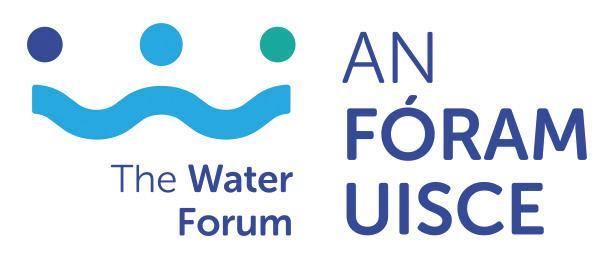
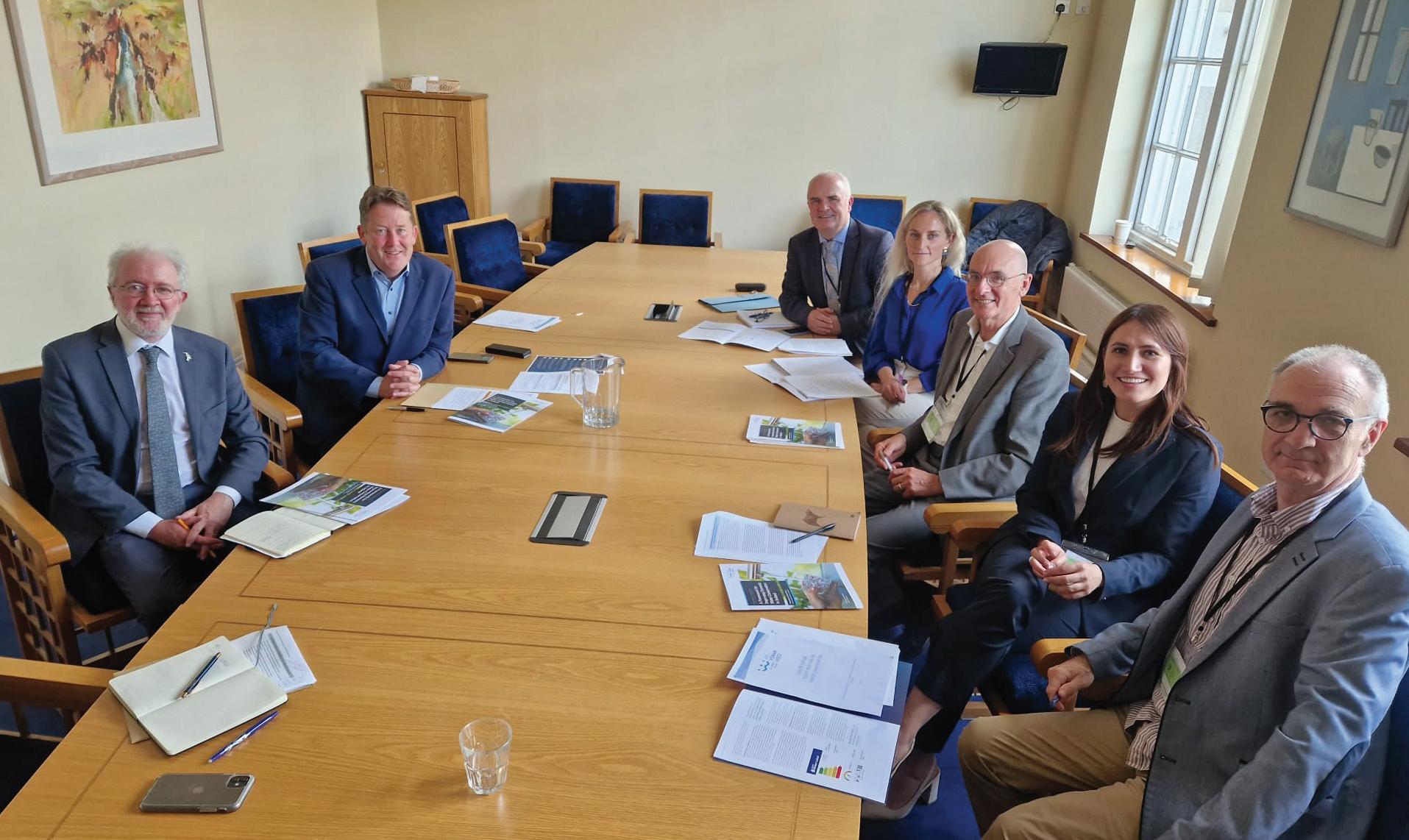
Despite Ireland being perceived as a ‘wet’ country, the greatest demand for water is in areas where there is least rainfall. A 30 per cent population growth in the past two decades substantially increases demand for water and expands economic needs. Climate change impacts will exacerbate the challenges in water supply.
In 2018 and again in 2020, Uisce Éireann (Irish Water) issued national water conservation orders (hosepipe bans) and this year ran a national water conservation campaign during the recent warm dry spell. One of the Water Forum’s statutory functions is to advise the Minister for Housing, Local
Government and Heritage on water policy, we have outlined below how we developed our position on water conservation.
We commission research to ensure policy recommendations are based on the latest science and data. In 2021,
Sarah Cotterill, Assistant Professor at University College Dublin, completed commissioned research on domestic water conservation. This report titled, A Framework for Improving Domestic Water Conservation in Ireland presented 10 policy recommendations including: • establish a national water conservation team to develop and
implement a national water conservation strategy in Ireland;
• update building regulations in Ireland to specify total water use per building and maximum ratings for fittings; and
• rethink water education to support a bottom-up understanding of water linked to the Irish curriculum.
Following presentation of the research to members of the Water Forum, the Forum hosted two workshops to discuss the policy recommendations in more detail. The first workshop focused on developing a national strategy for water conservation and the recommendation to update building regulations to include water efficiency targets. Attendees at the workshop included officials from the Department of Housing, Local Government and Heritage (including representatives from water policy and building regulations), the Irish Green Building Council, Uisce Éireann, National Federation of Group Water Schemes, Waterwise UK, and Water Forum members.
In 2023, a second workshop focused on the recommendation to develop a bottom-up understanding of water, linked to the national curriculum. A wide range of education stakeholders were invited to consider how water education could be improved in the school curriculum and in non-formal education settings. The Forum commissioned the development of cross-curriculum education modules to help build a bottom-up understanding of water resources, water and wastewater services in Ireland. Four modules that comprise of lesson plans, PowerPoint presentations and a student workbook are available to download for free from the Forum’s website and Scoilnet.ie (a Department of Education online resource centre for teachers).
Building on the research and workshops, the Forum then developed a Policy Position on Water Conservation which was submitted to the Minister and Department officials in May 2023. Recommendations included the establishment of a national water conservation team with a mandate to lead the development and implementation of a government-led water conservation strategy.
A Water Conservation Working Group has recently been set up by the Department to advise the Minister on a future strategy for water conservation and prioritisation of resources during periods of water stress.
In August 2023, the Water Forum commissioned a national survey of over 1,518 water consumers to gain an understanding of water consumers knowledge of and interest in water conservation and technologies. The survey found that:
• 74 per cent of respondents support water conservation measures but 59 per cent do not know how much water they use.
• 73 per cent said more information would help them manage their water use.
Based on these findings the Forum’s Water Survey Summary Report highlighted the need “for education and awareness on how to increase water efficiency in the home, to take advantage of the strong consumer support for conservation”.
The Water Forum has also called for a review of building regulations to ensure that new buildings are not only energy efficient, but also water efficient to help conserve water resources. Cost-benefit analysis research commissioned by the Water Forum shows that fitting water saving devices (e.g. efficient taps, showers and toilets) in the 300,000 new houses committed to be built over the next five years has the potential to save money as well as water resources.
The researchers, John Gallagher and Laurence Gill of Trinity College Dublin used a baseline of water use of 110 litres per person per day (LPD) to represent a new-build, four-person family home. For the cost-benefit-analysis, the researchers used a combined cost to the state of €4.40 per m3 (1,000 litres) for water and wastewater services, (which equates to €2.19 per m3 for drinking water and €2.21 per m3 for wastewater) based on Uisce Éireann data. The analysis shows that:
• low to moderate cost water saving technologies (taps, showers and toilets) would cost developers less than €180 per household;
• reducing water usage from an estimated baseline of 110 LPD to 90
LPD across the planned 303,000 new homes could save 2.2 million cubic metres of water per year;
• this would result in saving of up to €9.7 million in state costs for water and wastewater services to 2030 (Uisce Éireann);
• alongside an additional potential energy savings for households of €30 million per year (approximately €100 per household);
• reduced hot water consumption through more efficient taps and showers could reduce household energy costs by up to €280 per year; and
• these technologies would also reduce a household’s carbon emissions by 70 and 93 kg CO2 eq. in electrical energy savings, equating to an estimated reduction of 1.5 per cent of the average Irish person’s annual carbon emissions.
Uisce Éireann has indicated that water supply constraints in some areas of the country hamper meeting the Government’s housing targets. The research and Summary Report: The Value of Water Conservation confirms that using water saving technologies and setting water efficiency targets for new builds would reduce water demand, relieve pressure on water and wastewater infrastructure, and it would help unlock capacity for additional housing, particularly in areas with water supply constraints.
This example of bringing science to policy through a national stakeholder body, illustrates the positive impact the Water Forum is having on national policies and water management.
The Forum is very supportive of advancements in the establishment of the National Water Conservation Working Group, and we will provide scientific support and input from stakeholders to progress the work of this group.
We will continue to inform and engage to make sure those who wish to conserve water in their homes are empowered to do so.
W: www.thewaterforum.ie

Excess water charges will not be introduced ‘at this time’
Although domestic water charges were abolished nearly a decade ago, the potential for their return is yet to fully evaporate.
The Government has dropped plans for an excess water charge for domestic households. Minister for Housing James Browne TD “is not giving consideration at this time to bringing in such charges”, according to a spokesperson for the Department.
“No proposal has been brought to the minister in this regard, and charges do not form part of the current programme for government,” the spokesperson adds.
Furthermore, Taoiseach Micheál Martin TD has affirmed: “There will be no return to water charges.”
However, speculation had arisen in October 2024, when Uisce Éireann published its Water Charges Plan which outlined a maximum allowance of 213,000 litres of water per annum per domestic household. If this allowance is breached, the water utility suggested, a household would be liable for a charge of €1.85 per 1,000 litres of water used. Charges would be capped at €250. This would apply to both wastewater and
drinking water.
In March 2025, Deputy Browne said the charges were “intended to encourage water conservation and not designed as a revenue raising measure”.
Opposition TDs criticised the proposals, with Eoin Ó Broin TD, Sinn Féin spokesperson for housing, saying the policy was an attempt to implement water charges “by the back door”.
“The claim that the introduction of a charge for so-called excessive water usage is a water conservation measure is utterly false.”
“The Government’s real intention will be to introduce the principle of charging for domestic water services as the first step in water charges being applied to all households,” he said.
Excess water charges were planned to be introduced in 2019, but were first postponed until 2022, and then 2025.
Following the latest announcement, Sinn Féin leader, Mary Lou McDonald TD and Deputy Ó Broin submitted draft legislation to rule out the reintroduction of water charges.
Ireland remains the only country in the EU that has not implemented domestic water charges. Instead, Uisce Éireann is largely funded through general taxation, with the Department of Housing, Local Government and Heritage providing 80 per cent of the state-owned company’s funding, with non-domestic charges and connection fees accounting for the remaining 20 per cent.
Charging for water has been a political football for almost half a century. In 2017, charges for domestic households were abolished following widespread public protests having been reintroduced in 2014 as an austerity measure.
Published in November 2016, a report from the Joint Committee on the Future Funding of Domestic Water Services supported holding a referendum on whether public ownership of water services should be enshrined in the Constitution, effectively allowing privatisation only in the case of a public vote.
Despite pressure from activists and trade unions, no such referendum has been held to date or been seriously considered by government.